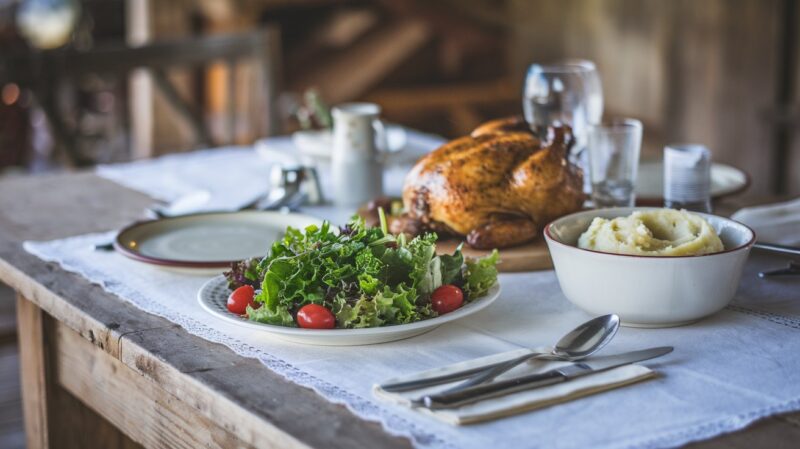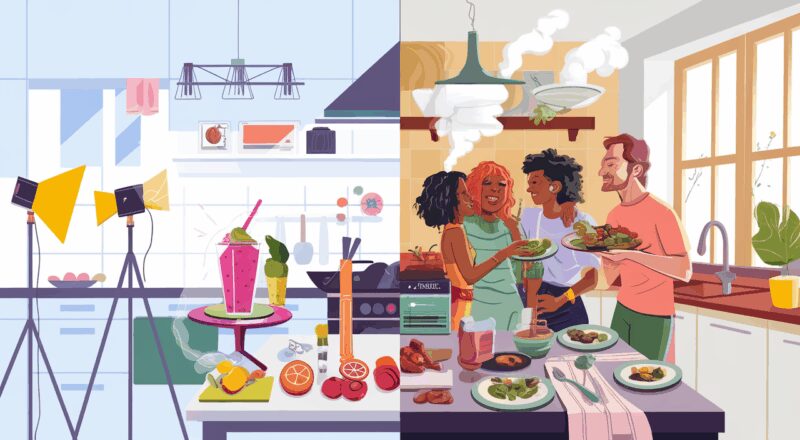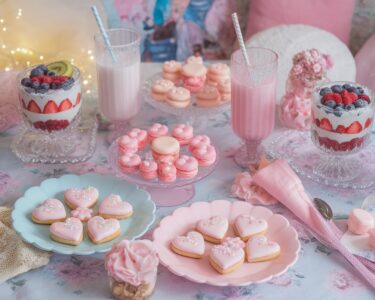Pretty Plate Pressure: Social media has turned everyday cooking into high-pressure art direction, with Instagram’s 400 million #foodporn posts creating unrealistic standards for home cooks. This “pretty plate pressure” shifts focus from cooking enjoyment and nourishment to the stress of creating picture-perfect meals for social validation.
Key Takeaways
- Over 60% of Instagram users follow food-related accounts, exposing them to perfectly styled dishes that create unrealistic standards for everyday meals.
- Professional-looking food photos typically involve strategic lighting, editing apps, styling tricks, and props that aren’t practical for regular meal preparation.
- Warning signs of unhealthy food styling include spending more time arranging food than enjoying it, feeling anxious about unphotogenic meals, and choosing foods based on appearance rather than nutrition.
- The pressure to create Instagram-worthy plates can lead to mental health issues, including a new form of social anxiety around food presentation.
- Breaking free from pretty plate pressure involves creating photo-free meal zones, practicing mindful eating without digital distractions, and focusing on the nourishment and satisfaction food provides rather than its appearance.
I’ve noticed this trend growing rapidly in recent years. The pressure to plate food perfectly has shifted from professional kitchens to home dining tables. What started as inspiration has morphed into an exhausting standard that drains the joy from cooking.
Food styling once belonged exclusively to professional photographers and magazine editors, but smartphones have democratized this art form while simultaneously creating impossible expectations. Professional food photographers use tricks like motor oil instead of syrup or glue instead of milk — techniques that make food look amazing but render it inedible.
Mental Health and the Rise of Food Anxiety
The mental health impact can’t be ignored. I’ve seen friends delay eating while their food gets cold, just to capture the perfect angle. This creates a disconnect between food’s primary purpose — nourishment and enjoyment — and its new role as a status symbol or artistic creation.
Practical Strategies to Reduce Pretty Plate Pressure
- Establish tech-free eating zones to reclaim mealtime as a digital-free space.
- Set time limits on food photography to prevent it from delaying or disrupting the eating experience.
- Celebrate imperfect meals as a reminder that taste and nourishment outweigh appearance.
Remember that taste matters more than appearance, and celebrate the imperfections of homemade meals. The most meaningful food experiences often come from dishes that would never make it to an Instagram feed.
The Hidden Cost of Instagram-Perfect Meals
Pretty Plate Pressure in the Social Media Age
I’ve noticed how social media has transformed simple meal preparation into an art-directed production. With over 400 million #foodporn posts on Instagram, the pressure to create pretty plates is real and increasingly intense. Like many home cooks exploring trendy plate aesthetics, I’ve felt the push to present picture-perfect meals.
The numbers tell a compelling story — more than 60% of Instagram users follow food-related accounts, showing just how deeply food styling has become part of our daily social media consumption. This constant exposure to perfectly styled dishes creates an unrealistic standard that’s hard to match in real life.
The Reality Behind Perfect Food Photos
The pretty plate pressure doesn’t just come from professional food stylists anymore. I’ve seen how creative plating challenges and trends have exploded across platforms, making everyday meals feel inadequate if they’re not camera-ready.
Here’s what’s typically happening behind those perfect food photos:
- Strategic lighting setups and multiple takes
- Editing apps that enhance colors and textures
- Food styling tricks that make dishes look fuller
- Props and backgrounds carefully chosen for aesthetic appeal
- Dishes often styled cold to look better on camera
The impact of this pretty plate pressure extends beyond social media. I’ve watched as snack plate styling has become an art form, with parents feeling pressured to create Instagram-worthy meals. Even casual family meals now come with the added stress of looking social media-ready.
Food influencers often set impossibly high standards with their polished presentations. While they might spend hours styling a single dish, most home cooks are juggling multiple responsibilities while trying to get food on the table. This disconnect between social media perfection and everyday reality creates unnecessary stress and anxiety around meal preparation.
The pressure to create picture-perfect plates has shifted our focus from the joy of cooking to the stress of presentation. What used to be simple family meals have turned into staging grounds for potential social media content, adding another layer of complexity to daily food preparation.
When Pretty Plates Harm Mental Health
The Dark Side of Pretty Plate Pressure
I’ve noticed a concerning trend where the pretty plate pressure on social media is creating real mental health challenges. The constant barrage of perfectly styled food photos isn’t just changing how we eat – it’s affecting our relationship with food itself. This obsession with picture-perfect meals has created a new form of social anxiety, where people feel judged not just for what they eat, but how photogenic their food looks.
Signs Your Food Styling Has Gone Too Far
The pursuit of pretty plate pressure can manifest in several concerning ways. Like the growing popularity of aesthetic beige plates and rainbow plate challenges, these trends might seem fun but can hide darker implications. Even innocent-looking snack plate aesthetics can trigger comparison and anxiety.
Here are the warning signs that food styling might be harming your mental health:
- Spending more time arranging food than enjoying it
- Feeling anxious if your meals don’t look ‘Instagram-worthy’
- Letting food go cold while trying to capture the perfect shot
- Throwing away food that doesn’t look picture-perfect
- Choosing meals based on appearance rather than nutrition
- Comparing your plates to others’ and feeling inadequate
The pretty plate pressure has gotten so intense that some parents are even feeling stressed about creating picture-perfect toddler plates. This shift from focusing on nourishment to presentation isn’t just superficial – it can develop into more serious issues like orthorexia nervosa, an unhealthy fixation with ‘correct’ eating.
I’ve seen how this pressure transforms simple meals into performances, where the act of eating becomes secondary to documenting. The constant need to style, photograph, and share our meals isn’t just time-consuming – it’s mentally exhausting. Your worth isn’t measured by how pretty your plate looks, and it’s crucial to remember that social media represents a curated reality, not real life.

Breaking Free from Food Photography Pressure
The Reality of Pretty Plate Pressure
I’ve noticed how pretty plate pressure has transformed simple meals into time-consuming photo shoots. Take smoothie bowls – they’ve become the poster child for this phenomenon. While these colorful creations can take up to 20 minutes to style perfectly, the actual enjoyment only lasts about 5 minutes. Just like the growing interest in beige plate aesthetics, this obsession with picture-perfect plating can overshadow what really matters – nutrition and taste.
The pretty plate pressure extends beyond our kitchens into social settings. Instead of engaging in meaningful conversations, I’ve seen countless dining experiences turn into impromptu photo sessions. This shift mirrors the growing trend of aesthetic snack plates that prioritize appearance over substance.
Reclaiming Joy in Food and Cooking
Here are practical steps I’ve found helpful in breaking free from the pretty plate pressure:
- Set specific meals as “photo-free zones”
- Focus on the aroma, texture, and flavors while eating
- Create simple, satisfying dishes without styling them
- Practice mindful eating without digital distractions
I’ve discovered that following diverse food accounts, including those showcasing rainbow plate challenges, can help build a more balanced social media feed. These accounts often highlight realistic meals that celebrate both nutrition and natural beauty.
The rising toddler plate trend reminds us that food presentation doesn’t need to be complex to be appealing. By shifting focus from external validation to personal satisfaction, I’ve found genuine joy in cooking again. It’s liberating to plate food based on practicality and personal preference rather than pretty plate pressure and social media standards.
Remember, a meal’s worth isn’t measured in likes or shares — it’s in the nourishment it provides and the satisfaction it brings. By prioritizing these aspects, you can create a healthier relationship with food that goes beyond surface-level aesthetics.
Many home cooks now feel the need to arrange their meals artfully, influenced by the rise of social media and the growing trend of showcasing aesthetically pleasing dishes, as explored in this piece on food presentation trends.
Sources:
The Atlantic – Pretty Food Is a Trap
Psychology Today – Instagram Food: When Does Healthy Eating Become Unhealthy Obsession?
EPA – Food Waste Reports
MDPI – International Journal of Environmental Research and Public Health
Springer – Journal of Technology in Behavioral Science
Elsevier – Appetite
American Psychological Association – Practice Innovations







